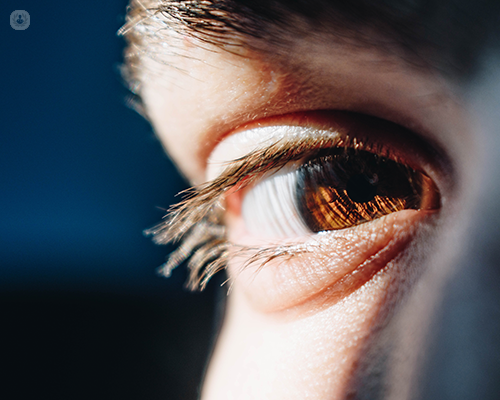Your guide to full-thickness macular holes and surgery
Written by:Macular holes happen when there is a gap all the way through your retina. The condition can be quite frightening due to its impact on vision quality but thankfully, ophthalmologists such as Mr Alistair Laidlaw are on hand to provide treatment. Mr Laidlaw is a specialist in treating macular holes and he provides you with an explanation of the condition along with what to expect regarding surgery, how it’s performed and its success rate.

What is the macula?
The retina is a light-sensitive membrane that lines the inside of the eye, similar to film in a camera. In the very central part of the retina is the macula, which is the part that you use for reading and other visually detailed tasks.
The macula has a very specific structure. It is not unlike a bicycle wheel in that there are radial fibres, like spokes, which run inwards and meet at a central point. Unlike a bicycle wheel, there is no central hub. The spokes therefore just sit together.
What is a full-thickness macular hole?
Pulling of the vitreous jelly (a gel-like substance that fills most of the eye) inside the eye can result in a split in the central macula and there is no loss of tissue associated with that split. If there is a gap all the way through the retina it is called a full-thickness macular hole.
Can it be confused with other conditions?
There are conditions which are caused by pulling on the central retina which do not result in a hole all the way through the central macula. These can be confused with full-thickness holes but will often behave differently.
One of these is vitreomacular traction (VMT) and this can sometimes lead to a full-thickness macular hole. There are other conditions which are sometimes termed partial-thickness macular holes although this is not a specific diagnosis. More specific terms for such partial-thickness holes are lamellar macular hole or macular pseudohole.
A full-thickness macular hole is not a feature of age-related macular degeneration as the processes that cause them are very different. Unlike macular degeneration, full-thickness macular holes usually only affect one eye.
What are the symptoms?
The typical symptoms of a full-thickness macular hole are a blurred or darker central patch in a person’s vision along with distortion. Usually, this only affects the central part of vision. The distortion and central impaired patch can cause problems when both eyes are open, even though only one eye has a macular hole: the affected eye is often said to interfere with the other.
Can macular holes resolve on their own?
A small proportion of full-thickness macular holes will go away on their own, usually in the first month or so. However, most become larger with time. As a result, central vision progressively becomes worse so that only the top line of the test chart can be seen. It is, however, usually only the central part of the vision that is affected by a full-thickness macular hole, the surrounding vision usually remains normal.
How are macular holes treated?
Macular holes are usually treated with surgery. There was a vogue for using an injected enzyme a few years ago but that is rarely used now due to a lack of effectiveness and side effects. Surgery is successful in a large proportion of cases. A vitrectomy is usually a day case operation and performed under local anaesthetic. As part of the operation, the jelly within the eye (the vitreous) is removed and a very thin membrane on the inner surface of the retina peeled away. This alters the pulling on the central part of the retina that caused the split to develop. A gas bubble is then put in the eye to allow the hole to close.
This paragraph is about whether people need to spend time face down (aka prone posturing) after macular hole surgery. In larger holes, about one in ten more will close with some face down posturing compared with those who don’t lay face down, i.e. an increase from 85 to 95%. Many people are very concerned about the face-down posturing. The gas bubble has to be in contact with the macular hole. In smaller holes, this can be adequately achieved in a normal sitting position. If the hole is larger than average, there is a small but definite benefit from spending six hours per day for five days with your forehead pointing at the floor. About 1 in 10 macular holes (i.e. 85% to 95% overall) will close with such face-down positioning or posturing. It can be seen from this that face down positioning is helpful rather than vital.
The gas bubble is absorbed over between three and six weeks. There are some important limitations on your activity with a gas bubble in the eye: you cannot fly, drive or have a general anaesthetic without informing the anaesthetist that there is a gas bubble in your eye.
People who undergo macular hole surgery will usually develop a cataract if cataract surgery has not already been done. For this reason, cataract surgery is often offered as a preventative measure and as part of the macular hole procedure.
What is the success rate of macular hole surgery?
Success rates in macular hole surgery depend greatly on the size of the hole before surgery. With smaller holes, more than 95% can be expected to close with one operation. The bigger the hole, the lower the chance of success, but even with big holes around 7 out of 10 might be expected to close.
The visual effects of closing a macular hole are that the distortion is reduced and the vision stops getting worse. The eye does not return entirely back to normal however and there is always some distortion in the very centre of vision. Successful macular hole surgery also usually allows the two eyes to work better together. Patients report that they are less aware of the bad eye interfering with the good one.
If the operation fails to close the hole then the vision tends to be no worse than before the surgery.
Is there a risk of complications?
As with any surgery, there is a risk of complications but these are fortunately rare with vitrectomy for macular holes. It is, however, important to be aware that there is a small but ever-present risk of worse vision or more surgery.
Is surgery worth it?
Most people who undergo macular hole surgery are pleased that they have had it done. The procedure usually works: the vision is usually better; the eye stops deteriorating and the process is not that bad to go through.
If you wish to discuss the treatment of your full-thickness macular hole, don’t hesitate to get in touch with Mr Laidlaw by clicking here to make an appointment.


